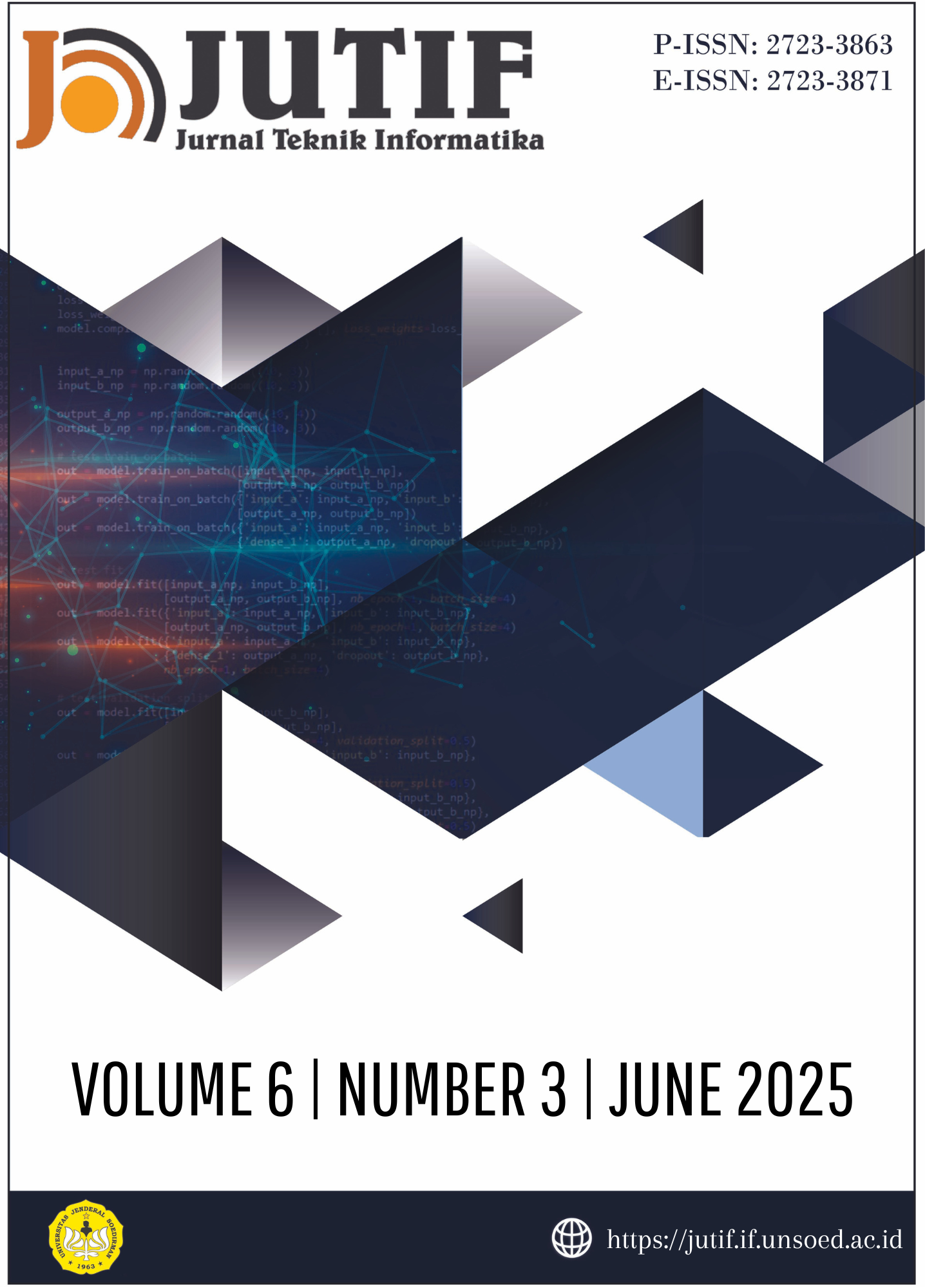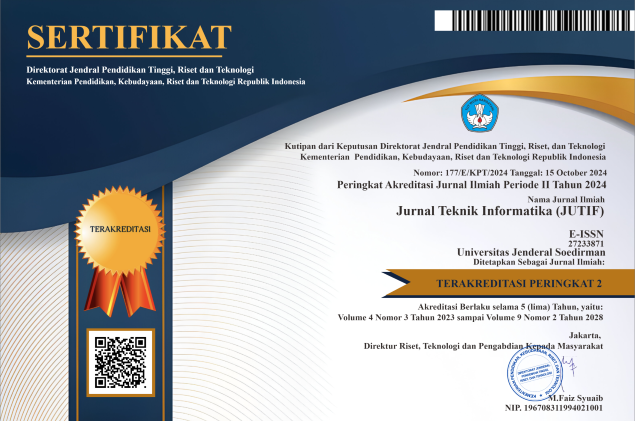Impact of Optimizer Selection on MobileNetV1 Performance for Skin Disease Detection Using Digital Images
DOI:
https://doi.org/10.52436/1.jutif.2025.6.3.4685Keywords:
CNN, Hyperparameter, Image Classification, MobileNetV1, Optimizer, Skin DiseaseAbstract
Automatic detection of skin diseases using digital images is a growing field in the application of deep learning in the medical world, especially to help the early diagnosis process. One of the most widely used models is MobileNetV1 because it is lightweight and efficient in image processing. However, the performance of the model is greatly affected by the training configuration, including the type of optimizer used. This study aims to compare the effectiveness of six types of optimizers, namely SGD, RMSprop, Adam, Adadelta, Adagrad, Adamax, and Nadam in training MobileNetV1 models for human skin disease image classification. The model was trained on annotated skin image dataset with predetermined training parameters: batch size 32, learning rate of 0.0001, and 10 epochs. Performance evaluation was performed using accuracy metrics. The results obtained demonstrate that RMSprop performs best, with 99.10% accuracy, 99.14% precision, 99.10% recall, and a 99.10% F1-score. Adadelta showed the lowest performance consistently, with only 22.22% accuracy, 20.34% precision, 22.22% recall, and 18.42% F1-score. This finding confirms that the type of optimizer affects the effectiveness of model training, especially in medical image classification tasks. This research provides empirical insights that are useful in selecting the optimal optimizer for MobileNetV1 model implementation in the healthcare domain.
Downloads
References
M. A. Richard et al., “Prevalence of most common skin diseases in Europe: a population‐based study,” J. Eur. Acad. Dermatology Venereol., vol. 36, no. 7, pp. 1088–1096, Jul. 2022, doi: 10.1111/jdv.18050.
K. Vayadande, A. A. Bhosle, R. G. Pawar, D. J. Joshi, P. A. Bailke, and O. Lohade, “Innovative approaches for skin disease identification in machine learning: A comprehensive study,” Oral Oncol. Reports, vol. 10, no. April, p. 100365, Jun. 2024, doi: 10.1016/j.oor.2024.100365.
G. Nikolakis, A. G. Vaiopoulos, I. Georgopoulos, E. Papakonstantinou, G. Gaitanis, and C. C. Zouboulis, “Insights, Advantages, and Barriers of Teledermatology vs. Face-to-Face Dermatology for the Diagnosis and Follow-Up of Non-Melanoma Skin Cancer: A Systematic Review,” Cancers (Basel)., vol. 16, no. 3, p. 578, Jan. 2024, doi: 10.3390/cancers16030578.
T. G. Debelee, “Skin Lesion Classification and Detection Using Machine Learning Techniques: A Systematic Review,” Diagnostics, vol. 13, no. 19, 2023, doi: 10.3390/diagnostics13193147.
J. A. Fee, F. P. McGrady, and N. D. Hart, “Dermoscopy use in primary care: a qualitative study with general practitioners,” BMC Prim. Care, vol. 23, no. 1, pp. 1–10, 2022, doi: 10.1186/s12875-022-01653-7.
K. A. Muhaba, K. Dese, T. M. Aga, F. T. Zewdu, and G. L. Simegn, “Automatic skin disease diagnosis using deep learning from clinical image and patient information,” Ski. Heal. Dis., vol. 2, no. 1, 2022, doi: 10.1002/ski2.81.
T. D. Nigat, T. M. Sitote, and B. M. Gedefaw, “Fungal Skin Disease Classification Using the Convolutional Neural Network,” J. Healthc. Eng., vol. 2023, 2023, doi: 10.1155/2023/6370416.
Y. Yang, L. Qu, I. Mijakovic, and Y. Wei, “Advances in the human skin microbiota and its roles in cutaneous diseases,” Microb. Cell Fact., vol. 21, no. 1, pp. 1–14, 2022, doi: 10.1186/s12934-022-01901-6.
A. M. Thawabteh, A. Jibreen, D. Karaman, A. Thawabteh, and R. Karaman, “Skin Pigmentation Types, Causes and Treatment—A Review,” Molecules, vol. 28, no. 12, 2023, doi: 10.3390/molecules28124839.
B. Seshakagari and H. Reddy, “Deep Learning-Based Detection of Hair and Scalp Diseases Using CNN and Image Processing,” pp. 145–155, 2025, doi: 10.5281/zenodo.14965660.
N. Hasan et al., “Skin cancer: understanding the journey of transformation from conventional to advanced treatment approaches,” Mol. Cancer, vol. 22, no. 1, pp. 1–70, 2023, doi: 10.1186/s12943-023-01854-3.
B. Yang et al., “DrHouse: An LLM-empowered Diagnostic Reasoning System through Harnessing Outcomes from Sensor Data and Expert Knowledge,” Proc. ACM Interactive, Mobile, Wearable Ubiquitous Technol., vol. 8, no. 4, pp. 1–29, Nov. 2024, doi: 10.1145/3699765.
E. I. Adesanya et al., “Factors associated with depression, anxiety and severe mental illness among adults with atopic eczema or psoriasis: A systematic review and meta-analysis,” Br. J. Dermatol., vol. 188, no. 4, pp. 460–470, 2023, doi: 10.1093/bjd/ljac132.
F. Jafarzadeh, F. Rahmani, F. Azadmehr, M. Falaki, and M. Nazari, “Different applications of telemedicine - assessing the challenges, barriers, and opportunities- a narrative review,” J. Fam. Med. Prim. Care, vol. 11, no. 3, pp. 879–886, Mar. 2022, doi: 10.4103/jfmpc.jfmpc_1638_21.
A. Yakupu et al., “The burden of skin and subcutaneous diseases: findings from the global burden of disease study 2019,” Front. Public Heal., vol. 11, 2023, doi: 10.3389/fpubh.2023.1145513.
R. I. Mukhamediev et al., “Review of Artificial Intelligence and Machine Learning Technologies: Classification, Restrictions, Opportunities and Challenges,” Mathematics, vol. 10, no. 15, pp. 1–25, 2022, doi: 10.3390/math10152552.
D. Touretzky, C. Gardner-McCune, and D. Seehorn, Machine Learning and the Five Big Ideas in AI, vol. 33, no. 2. Springer New York, 2023. doi: 10.1007/s40593-022-00314-1.
S. Garg, K. Arora, S. Singh, and K. Nagarajan, “Artificial intelligence and machine learning in drug discovery and development,” Artif. Intell. Age Nanotechnol., pp. 42–61, 2023, doi: 10.4018/9798369303689.ch003.
R. Obuchowicz, M. Strzelecki, and A. Piórkowski, “Clinical Applications of Artificial Intelligence in Medical Imaging and Image Processing—A Review,” Cancers (Basel)., vol. 16, no. 10, p. 1870, May 2024, doi: 10.3390/cancers16101870.
U. Kulkarni, S. M. Meena, S. V. Gurlahosur, and G. Bhogar, “Quantization Friendly MobileNet (QF-MobileNet) Architecture for Vision Based Applications on Embedded Platforms,” Neural Networks, vol. 136, pp. 28–39, 2021, doi: 10.1016/j.neunet.2020.12.022.
A. Pfob, S. C. Lu, and C. Sidey-Gibbons, “Machine learning in medicine: a practical introduction to techniques for data pre-processing, hyperparameter tuning, and model comparison,” BMC Med. Res. Methodol., vol. 22, no. 1, pp. 1–15, 2022, doi: 10.1186/s12874-022-01758-8.
R. Abdulkadirov, P. Lyakhov, and N. Nagornov, “Survey of Optimization Algorithms in Modern Neural Networks,” Mathematics, vol. 11, no. 11, p. 2466, May 2023, doi: 10.3390/math11112466.
V. Anand, S. Gupta, D. Koundal, S. Mahajan, A. K. Pandit, and A. Zaguia, “Deep learning based automated diagnosis of skin diseases using dermoscopy,” Comput. Mater. Contin., vol. 71, no. 2, pp. 3145–3160, 2022, doi: 10.32604/cmc.2022.022788.
D. M. R. Sari, S. Nurmaini, D. P. Rini, and A. I. Sapitri, “Dermatitis Atopic and Psoriasis Skin Disease Classification by using Convolutional Neural Network,” Comput. Eng. Appl. J., vol. 12, no. 1, pp. 1–10, Feb. 2023, doi: 10.18495/comengapp.v12i1.419.
R. Saifan and F. Jubair, “Six skin diseases classification using deep convolutional neural network,” Int. J. Electr. Comput. Eng., vol. 12, no. 3, p. 3072, Jun. 2022, doi: 10.11591/ijece.v12i3.pp3072-3082.
K. Park, M. Chae, and J. H. Cho, “Image Pre-Processing Method of Machine Learning for Edge Detection with Image Signal Processor Enhancement,” Micromachines, vol. 12, no. 1, p. 73, Jan. 2021, doi: 10.3390/mi12010073.
V. R. Joseph, “Optimal ratio for data splitting,” Stat. Anal. Data Min., vol. 15, no. 4, pp. 531–538, 2022, doi: 10.1002/sam.11583.
K. Maharana, S. Mondal, and B. Nemade, “A review: Data pre-processing and data augmentation techniques,” Glob. Transitions Proc., vol. 3, no. 1, pp. 91–99, 2022, doi: 10.1016/j.gltp.2022.04.020.
R. Sarki, K. Ahmed, H. Wang, Y. Zhang, J. Ma, and K. Wang, “Image Preprocessing in Classification and Identification of Diabetic Eye Diseases,” Data Sci. Eng., vol. 6, no. 4, pp. 455–471, 2021, doi: 10.1007/s41019-021-00167-z.
S. Boskovic, L. Svadlenka, S. Jovcic, M. Dobrodolac, V. Simic, and N. Bacanin, “An Alternative Ranking Order Method Accounting for Two-Step Normalization (AROMAN) - A Case Study of the Electric Vehicle Selection Problem,” IEEE Access, vol. 11, no. March, pp. 39496–39507, 2023, doi: 10.1109/ACCESS.2023.3265818.
A. Zafar et al., “A Comparison of Pooling Methods for Convolutional Neural Networks,” Appl. Sci., vol. 12, no. 17, pp. 1–21, 2022, doi: 10.3390/app12178643.
V. S. Dhaka et al., “A survey of deep convolutional neural networks applied for prediction of plant leaf diseases,” Sensors, vol. 21, no. 14, 2021, doi: 10.3390/s21144749.
R. Sadik, S. Anwar, and L. Reza, “AutismNet: Recognition of Autism Spectrum Disorder from Facial Expressions using MobileNet Architecture,” Int. J. Adv. Trends Comput. Sci. Eng., vol. 10, no. 1, pp. 327–334, Feb. 2021, doi: 10.30534/ijatcse/2021/471012021.
B. Bischl et al., “Hyperparameter optimization: Foundations, algorithms, best practices, and open challenges,” WIREs Data Min. Knowl. Discov., vol. 13, no. 2, pp. 1–43, Mar. 2023, doi: 10.1002/widm.1484.
T. Elansari, M. Ouanan, and H. Bourray, “Mixed Radial Basis Function Neural Network Training Using Genetic Algorithm,” Neural Process. Lett., vol. 55, no. 8, pp. 10569–10587, 2023, doi: 10.1007/s11063-023-11339-5.
C. Vengaiah and S. R. Konda, “A Comparative Study of Convolutional Neural Network Architectures for Enhanced Tomato Leaf Disease Classification Using Refined Statistical Features,” Trait. du Signal, vol. 41, no. 1, pp. 201–212, Feb. 2024, doi: 10.18280/ts.410116.
S. Roy, R. Mehera, R. K. Pal, and S. K. Bandyopadhyay, “Hyperparameter optimization for deep neural network models: a comprehensive study on methods and techniques,” Innov. Syst. Softw. Eng., pp. 0–20, Oct. 2023, doi: 10.1007/s11334-023-00540-3.
M. Reyad, A. M. Sarhan, and M. Arafa, “A modified Adam algorithm for deep neural network optimization,” Neural Comput. Appl., vol. 35, no. 23, pp. 17095–17112, Aug. 2023, doi: 10.1007/s00521-023-08568-z.
K. M. Hamdia, X. Zhuang, and T. Rabczuk, “An efficient optimization approach for designing machine learning models based on genetic algorithm,” Neural Comput. Appl., vol. 33, no. 6, pp. 1923–1933, Mar. 2021, doi: 10.1007/s00521-020-05035-x.
Y. Tian, Y. Zhang, and H. Zhang, “Recent Advances in Stochastic Gradient Descent in Deep Learning,” Mathematics, vol. 11, no. 3, p. 682, Jan. 2023, doi: 10.3390/math11030682.
Y.-L. Peng and W.-P. Lee, “Practical guidelines for resolving the loss divergence caused by the root-mean-squared propagation optimizer,” Appl. Soft Comput., vol. 153, p. 111335, Mar. 2024, doi: 10.1016/j.asoc.2024.111335.
N. Attrapadung et al., “Adam in Private: Secure and Fast Training of Deep Neural Networks with Adaptive Moment Estimation,” Proc. Priv. Enhancing Technol., vol. 2022, no. 4, pp. 746–767, Oct. 2022, doi: 10.56553/popets-2022-0131.
R. Elshamy, O. Abu-Elnasr, M. Elhoseny, and S. Elmougy, “Enhancing colorectal cancer histology diagnosis using modified deep neural networks optimizer,” Sci. Rep., vol. 14, no. 1, p. 19534, Aug. 2024, doi: 10.1038/s41598-024-69193-x.
R. S. Kale and S. Shitole, “Deep learning optimizer performance analysis for pomegranate fruit quality gradation,” in 2022 IEEE Bombay Section Signature Conference (IBSSC), Dec. 2022, pp. 1–5. doi: 10.1109/IBSSC56953.2022.10037429.
P. Das, S. Gupta, J. Patra, and B. Mondal, “ADAMAX optimizer and CATEGORICAL CROSSENTROPY loss function-based CNN method for diagnosing Lung cancer,” in 2023 7th International Conference on Trends in Electronics and Informatics (ICOEI), Apr. 2023, pp. 806–810. doi: 10.1109/ICOEI56765.2023.10126046.
J. Sharma et al., “A novel long term solar photovoltaic power forecasting approach using LSTM with Nadam optimizer: A case study of India,” Energy Sci. Eng., vol. 10, no. 8, pp. 2909–2929, Aug. 2022, doi: 10.1002/ese3.1178.
K. Ali, Z. A. Shaikh, A. A. Khan, and A. A. Laghari, “Multiclass skin cancer classification using EfficientNets – a first step towards preventing skin cancer,” Neurosci. Informatics, vol. 2, no. 4, p. 100034, 2022, doi: 10.1016/j.neuri.2021.100034.
M. Taqiyuddin, K. Adi, O. Dwi Nurhayati, and H. Ochi, “Comparison of Optimizers for Drone Signal Detection Using Convolutional Neural Networks (CNN),” E3S Web Conf., vol. 448, 2023, doi: 10.1051/e3sconf/202344802025.
M. Z. Hussain et al., “A fine-tuned convolutional neural network model for accurate Alzheimer’s disease classification,” Sci. Rep., vol. 15, no. 1, pp. 1–24, 2025, doi: 10.1038/s41598-025-86635-2.
Deepika Kumari, Santosh Kumar Singh, Sanjay Subhash Katira, Inumarthi V Srinivas, and Uday Salunkhe, “Benchmarking Optimizers in Transfer Learning for Automated Weed Image Recognition,” Metall. Mater. Eng., vol. 31, no. 4, pp. 1–10, Apr. 2025, doi: 10.63278/1376.
V. H. Sahin, I. Oztel, and G. Yolcu Oztel, “Human Monkeypox Classification from Skin Lesion Images with Deep Pre-trained Network using Mobile Application,” J. Med. Syst., vol. 46, no. 11, p. 79, Oct. 2022, doi: 10.1007/s10916-022-01863-7.
A. Mortazi, V. Cicek, E. Keles, and U. Bagci, “Selecting the best optimizers for deep learning–based medical image segmentation,” Front. Radiol., vol. 3, no. September, pp. 1–17, Sep. 2023, doi: 10.3389/fradi.2023.1175473.
Additional Files
Published
How to Cite
Issue
Section
License
Copyright (c) 2025 Khairul Fathan Habie, Murinto, Sunardi

This work is licensed under a Creative Commons Attribution 4.0 International License.



























